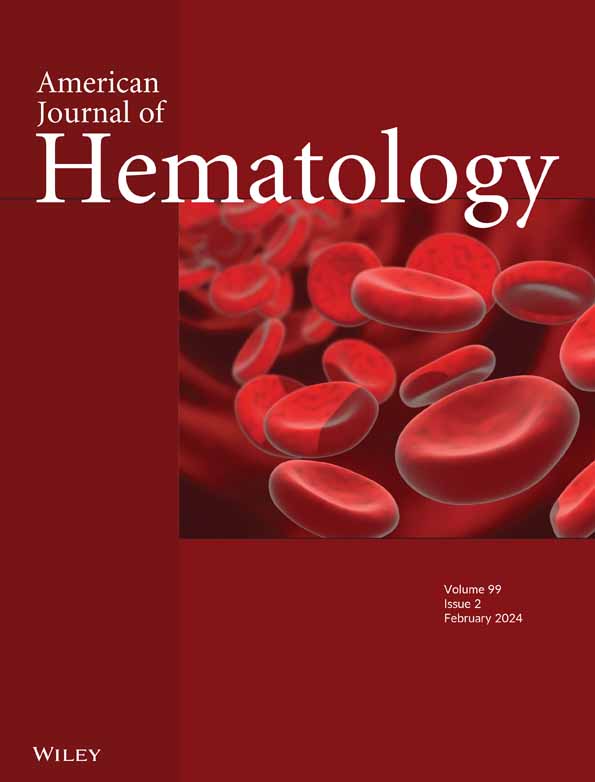Loss-Prone HLA Class I Alleles Inform Outcomes of Early Hematopoietic Cell Transplantation in Acquired Aplastic Anemia.
IF 9.9
1区 医学
Q1 HEMATOLOGY
引用次数: 0
Abstract
HLA class I allele loss in acquired aplastic anemia (AA) represents an immune escape from the T cell-mediated pathogenesis. We investigated the impact of loss-prone HLA alleles on the hematopoietic cell transplantation (HCT) outcomes using registry data of 875 Japanese patients with acquired AA. HLA associations were evident exclusively among 399 patients who received HCT within 1 year of the diagnosis, consistent with the predominance of HLA loss in this group. A set of five HLA alleles with the highest propensity for loss (HLA-A*02:01, HLA-A*02:06, HLA-A*31:01, HLA-B*40:02, and HLA-B*54:01) was the strongest predictor of post-transplant survival among all possible allele combinations (5-year survival, 80.3% vs. 54.4%; p < 0.0001), partly due to improved engraftment and pre-transplant conditions. Another set (HLA-A*33:03, HLA-B*07:02, HLA-B*44:03, HLA-B*52:01, and HLA-B*54:01)-less frequently lost in AA and underrepresented in Epstein-Barr virus (EBV)-related diseases outside AA-was associated with an increased risk of post-transplant lymphoproliferative disorders (5-year incidence, 10.2% vs. 1.8%; p = 0.00019), suggesting that the loss of protective alleles against EBV during AA pathogenesis may predispose to EBV-driven lymphoproliferations. These associations were determined by recipient, not donor, HLA. Therefore, specific HLA class I alleles and their potential loss significantly influence the HCT outcomes in acquired AA.易丢失的HLA I类等位基因影响获得性再生障碍性贫血患者早期造血细胞移植的结果。
获得性再生障碍性贫血(AA)的HLA I类等位基因缺失代表了T细胞介导的发病机制的免疫逃逸。我们利用875名日本获得性AA患者的注册数据,研究了易丢失HLA等位基因对造血细胞移植(HCT)结果的影响。在诊断后1年内接受HCT的399例患者中,HLA相关性明显,这与HLA丢失在该组中的优势一致。在所有可能的等位基因组合中,丢失倾向最高的5个HLA等位基因(HLA-A*02:01, HLA-A*02:06, HLA-A*31:01, HLA- b *40:02和HLA- b *54:01)是移植后生存的最强预测因子(5年生存率,80.3% vs. 54.4%, p < 0.0001),部分原因是移植前和移植前条件的改善。另一组(HLA-A*33:03, HLA-B*07:02, HLA-B*44:03, HLA-B*52:01和HLA-B*54:01)-在AA中较少丢失,在AA以外的EBV相关疾病中代表性不足-与移植后淋巴细胞增生性疾病的风险增加相关(5年发病率,10.2% vs. 1.8%; p = 0.00019),提示在AA发病过程中,EBV保护性等位基因的丢失可能易导致EBV驱动的淋巴细胞增殖。这些关联是由受体而非供体HLA决定的。因此,特异性HLA I类等位基因及其潜在缺失显著影响获得性AA患者的HCT结果。
本文章由计算机程序翻译,如有差异,请以英文原文为准。
求助全文
约1分钟内获得全文
求助全文
来源期刊
CiteScore
15.70
自引率
3.90%
发文量
363
审稿时长
3-6 weeks
期刊介绍:
The American Journal of Hematology offers extensive coverage of experimental and clinical aspects of blood diseases in humans and animal models. The journal publishes original contributions in both non-malignant and malignant hematological diseases, encompassing clinical and basic studies in areas such as hemostasis, thrombosis, immunology, blood banking, and stem cell biology. Clinical translational reports highlighting innovative therapeutic approaches for the diagnosis and treatment of hematological diseases are actively encouraged.The American Journal of Hematology features regular original laboratory and clinical research articles, brief research reports, critical reviews, images in hematology, as well as letters and correspondence.

 求助内容:
求助内容: 应助结果提醒方式:
应助结果提醒方式:


